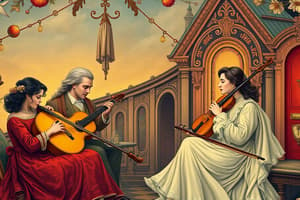Podcast
Questions and Answers
Mozart's Requiem was left unfinished at his death.
Mozart's Requiem was left unfinished at his death.
True (A)
For which event was Mozart's Requiem not chosen due to its expressive power?
For which event was Mozart's Requiem not chosen due to its expressive power?
The Funeral of Princess Diana
Mozart's Requiem is an example of a Classical-era oratorio.
Mozart's Requiem is an example of a Classical-era oratorio.
False (B)
Which of the following describe the Dies irae from Mozart's Requiem?
Which of the following describe the Dies irae from Mozart's Requiem?
Mozart's Requiem is a sacred piece of music.
Mozart's Requiem is a sacred piece of music.
Mozart died while writing which piece?
Mozart died while writing which piece?
For which of the following events was Mozart's Requiem chosen because of its expressive power?
For which of the following events was Mozart's Requiem chosen because of its expressive power?
In which language is the Dies irae from Mozart's Requiem written?
In which language is the Dies irae from Mozart's Requiem written?
The dramatic Dies irae section of Mozart's Requiem provides a vision of the Day of ______.
The dramatic Dies irae section of Mozart's Requiem provides a vision of the Day of ______.
In the Classical era, the main genres of sacred choral music were the _______ and the oratorio. A _______ is a musical setting of the Mass for the Dead.
In the Classical era, the main genres of sacred choral music were the _______ and the oratorio. A _______ is a musical setting of the Mass for the Dead.
Who completed the unfinished portions of Mozart's Requiem?
Who completed the unfinished portions of Mozart's Requiem?
Mozart wrote the text for the Dies irae.
Mozart wrote the text for the Dies irae.
Which of the following verses are found in the Dies irae from Mozart's Requiem?
Which of the following verses are found in the Dies irae from Mozart's Requiem?
Match the musical descriptions of Mozart's Dies irae from Requiem to their correct musical elements:
Match the musical descriptions of Mozart's Dies irae from Requiem to their correct musical elements:
The mood of Mozart's Dies irae from Requiem shifts from ______ fear in a ______ key to a ______ plea for salvation.
The mood of Mozart's Dies irae from Requiem shifts from ______ fear in a ______ key to a ______ plea for salvation.
Which describes the performers in the first two verses in the opening of the Dies irae from Mozart's Requiem?
Which describes the performers in the first two verses in the opening of the Dies irae from Mozart's Requiem?
Which of the following describes the first two verses of the Dies irae from Mozart's Requiem?
Which of the following describes the first two verses of the Dies irae from Mozart's Requiem?
Which describes the performers in the third verse of the Dies irae from Mozart's Requiem?
Which describes the performers in the third verse of the Dies irae from Mozart's Requiem?
Which describes the pace of the music from the third verse of the Dies irae from Mozart's Requiem?
Which describes the pace of the music from the third verse of the Dies irae from Mozart's Requiem?
Which of the following correctly describe the third verse of the Dies irae from Mozart's Requiem?
Which of the following correctly describe the third verse of the Dies irae from Mozart's Requiem?
Study Notes
Mozart's Requiem Overview
- Mozart's Requiem was left unfinished at his death.
- Known for its expressive power, it was chosen for significant events like JFK's funeral and the September 11 attack anniversary, but not for Princess Diana's funeral.
- It is a sacred piece of music and not classified as a Classical-era oratorio.
Dies irae Characteristics
- The Dies irae was composed for soloists, chorus, and orchestra, specifically presenting a vision of Judgment Day.
- Written in Latin, it features dramatic themes reflecting fear and a plea for salvation.
- The eighth verse is performed by a chorus with orchestral accompaniment, characterized by a slow tempo and loud dynamics.
Context and Legacy
- Completed by Franz Xaver Sussmayr after Mozart's death, the Requiem encompasses the genre of Mass, particularly the Requiem Mass for the Dead.
- The powerful composition has been used in various cultural and memorial contexts due to its emotional depth.
Musical Elements
- The Dies irae features a mix of major and minor harmonies, largely homophonic texture, and a duple rhythm.
- Opening verses involve a chorus and orchestra, with a fast pace and loud volume.
Specific Verses Analysis
- The text includes "Dies irae," "Tuba mirum," and "Rex tremendae," but excludes "Ave Maria" and "Stabat mater."
- The third verse is notably performed by trombone and solo bass voice, with a slow pace emphasizing its somber nature.
Performer and Performance Insights
- Initial verses highlight a fast tempo with a full chorus and orchestral sound.
- As the piece progresses, performers shift to solo arrangements, illustrating a transition from collective to individual interpretations of fear and solace in music.
Studying That Suits You
Use AI to generate personalized quizzes and flashcards to suit your learning preferences.
Description
Test your knowledge on Mozart's Requiem and its impact on music history. This quiz covers the unfinished nature of the composition, its expressive power, and notable events associated with it. Dive into the profound influence of this masterpiece in the realm of classical music.




